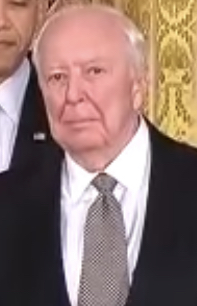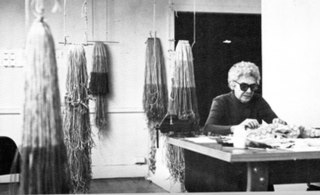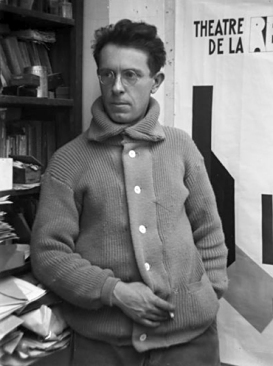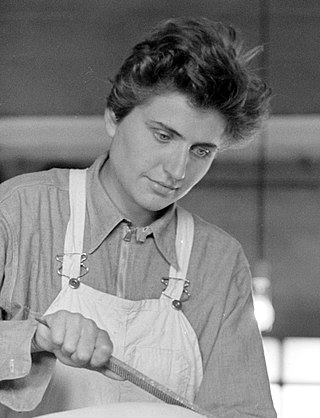
Multidimensional art is art that cannot be represented on a two-dimensional flat canvas. Artists create a third dimension with paper or another medium. [1] In multidimensional art an artist can make use of virtually any items (mediums).

Multidimensional art is art that cannot be represented on a two-dimensional flat canvas. Artists create a third dimension with paper or another medium. [1] In multidimensional art an artist can make use of virtually any items (mediums).
Many artists make use of the objects and items they find in nature and or man made items. Some artists use paper [2] and others make use of rubber, plastic, or sculpture. [3] Artists also use other man made items like: textiles, milk cartons, or beads. [4]
Japanese born Nobuhiro Nakanishi puts photos on see through plastic and orders the photos in chronological order. He then mounts the photos on a wall in a line (stacking them) which gives the viewer a different perspective. [5]

Drawing is a visual art that uses an instrument to mark paper or another two-dimensional surface. The instruments used to make a drawing are pencils, crayons, pens with inks, brushes with paints, or combinations of these, and in more modern times, computer styluses with graphics tablets or gamepads in VR drawing software.

Jasper Johns is an American painter, sculptor, draftsman, and printmaker. Considered a central figure in the development of American postwar art, he has been variously associated with abstract expressionism, Neo-Dada, and pop art movements.

Within the 20th century, there came the use of plastics in art. In the latter half of the century, plastic technology advanced so that it was feasible for artists to start using plastic and acrylics as an artwork medium.

Relief is a sculptural method in which the sculpted pieces remain attached to a solid background of the same material. The term relief is from the Latin verb relevare, to raise. To create a sculpture in relief is to give the impression that the sculpted material has been raised above the background plane. When a relief is carved into a flat surface of stone or wood, the field is actually lowered, leaving the unsculpted areas seeming higher. The approach requires a lot of chiselling away of the background, which takes a long time. On the other hand, a relief saves forming the rear of a subject, and is less fragile and more securely fixed than a sculpture in the round, especially one of a standing figure where the ankles are a potential weak point, particularly in stone. In other materials such as metal, clay, plaster stucco, ceramics or papier-mâché the form can be simply added to or raised up from the background. Monumental bronze reliefs are made by casting.

Paper craft is a collection of crafts using paper or card as the primary artistic medium for the creation of two or three-dimensional objects. Paper and card stock lend themselves to a wide range of techniques and can be folded, curved, bent, cut, glued, molded, stitched, or layered. Papermaking by hand is also a paper craft.

Assemblage is an artistic form or medium usually created on a defined substrate that consists of three-dimensional elements projecting out of or from the substrate. It is similar to collage, a two-dimensional medium. It is part of the visual arts and it typically uses found objects, but is not limited to these materials.

Fresco-secco is a wall painting technique where pigments mixed with an organic binder and/or lime are applied onto dry plaster. The paints used can e.g. be casein paint, tempera, oil paint, silicate mineral paint. If the pigments are mixed with lime water or lime milk and applied to a dry plaster the technique is called lime secco painting. The secco technique contrasts with the fresco technique, where the painting is executed on a layer of wet plaster.

Claire Zeisler was an American fiber artist who expanded the expressive qualities of knotted and braided threads, pioneering large-scale freestanding sculptures in this medium. Throughout her career Zeisler sought to create "large, strong, single images" with fiber.
Wire sculpture is the creation of sculpture or jewelry out of wire. The use of metal wire in jewelry dates back to the 2nd Dynasty in Egypt and to the Bronze and Iron Ages in Europe. In the 20th century, the works of Alexander Calder, Ruth Asawa, and other modern practitioners developed the medium of wire sculpture as an art form.

Soft sculpture is a type of sculpture or three dimensional form that incorporates materials such as cloth, fur, foam rubber, plastic, paper, fibre or similar supple and nonrigid materials. Soft sculptures can be stuffed, sewn, draped, stapled, glued, hung, draped or woven. These materials and techniques distinguish soft sculptures from more traditional hard sculptures made from, for example, stone, bronze or wood that are then carved or modelled.

Paper models, also called card models or papercraft, are models constructed mainly from sheets of heavy paper, paperboard, card stock, or foam.

Cubist sculpture developed in parallel with Cubist painting, beginning in Paris around 1909 with its proto-Cubist phase, and evolving through the early 1920s. Just as Cubist painting, Cubist sculpture is rooted in Paul Cézanne's reduction of painted objects into component planes and geometric solids; cubes, spheres, cylinders, and cones. Presenting fragments and facets of objects that could be visually interpreted in different ways had the effect of 'revealing the structure' of the object. Cubist sculpture essentially is the dynamic rendering of three-dimensional objects in the language of non-Euclidean geometry by shifting viewpoints of volume or mass in terms of spherical, flat and hyperbolic surfaces.

Bruce Obomeyoma Onobrakpeya is a Nigerian printmaker, painter and sculptor. He has exhibited at the Tate Modern in London, the National Museum of African Art of the Smithsonian Institution in Washington, D.C., and the Malmö Konsthall in Malmö, Sweden. The National Gallery of Modern Art, Lagos, has an exhibit of colourful abstract canvases by Onobrakpeya and his works can be found at the Virtual Museum of Modern Nigerian Art, although no exhibitions were showing as of October 2017.

The visual arts are art forms such as painting, drawing, printmaking, sculpture, ceramics, photography, video, filmmaking, comics, design, crafts, and architecture. Many artistic disciplines, such as performing arts, conceptual art, and textile arts, also involve aspects of the visual arts as well as arts of other types. Also included within the visual arts are the applied arts, such as industrial design, graphic design, fashion design, interior design, and decorative art.

Joseph Csaky was a Hungarian avant-garde artist, sculptor, and graphic artist, best known for his early participation in the Cubist movement as a sculptor. Csaky was one of the first sculptors in Paris to apply the principles of pictorial Cubism to his art. A pioneer of modern sculpture, Csaky is among the most important sculptors of the early 20th century. He was an active member of the Section d'Or group between 1911 and 1914, and closely associated with Crystal Cubism, Purism, De Stijl, Abstract art, and Art Deco throughout the 1920s and 1930s.

Modern sculpture is generally considered to have begun with the work of Auguste Rodin, who is seen as the progenitor of modern sculpture. While Rodin did not set out to rebel against the past, he created a new way of building his works. He "dissolved the hard outline of contemporary Neo-Greek academicism, and thereby created a vital synthesis of opacity and transparency, volume and void". Along with a few other artists in the late 19th century who experimented with new artistic visions in sculpture like Edgar Degas and Paul Gauguin, Rodin invented a radical new approach in the creation of sculpture. Modern sculpture, along with all modern art, "arose as part of Western society's attempt to come to terms with the urban, industrial and secular society that emerged during the nineteenth century".

Lenore Thomas Straus was an American sculptor and author.
Leo Monahan (1933) is an artist who is known for paper art. Monahan creates paper sculptures and multi-dimensional art work that cannot be represented on a two dimensional flat canvas. Monahan was involved with Chouinard Art Institute. Monahan was the first person to receive a Disney Scholarship to attend the Chouinard Art Institute and after graduation he worked for Disney for 50 years. Leo is an educator who teaches collage and assemblage, conveying basic design principles in an engaging manner. He is a master of color. He highlights the concepts of elements in relation to one another and the power of symbols. He is also proficient at the art of haiku.